Egypt
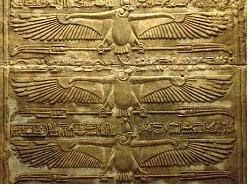 This is a list of some of the most important Egyptian artifacts not the property of Egypt's Ministry of Antiquities including the silver cult statue of Horus the Elder from the Miho Museum. This 36+ pound silver statue was once covered in thick gold sheeting and may well be the only surviving cult statue taken care of in its temple by its priests.
This is a list of some of the most important Egyptian artifacts not the property of Egypt's Ministry of Antiquities including the silver cult statue of Horus the Elder from the Miho Museum. This 36+ pound silver statue was once covered in thick gold sheeting and may well be the only surviving cult statue taken care of in its temple by its priests.
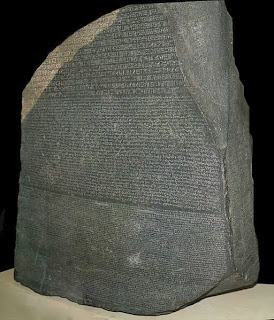
1. Rosetta stone (EA 24)- Discovered in the foundations of a fort at Rosseta by Napoleon's men in 1798 the stone was handed over to the British in the treaty of Alexandria in 1801. The stone was given to King George III who in turn donated it to the British Museum.
It is in fact the Rosseta stones modern history that gives its importance in the learning to read the Egyptian hieroglyphs, otherwise the stone would be of limited importance to ancient Egyptian history.
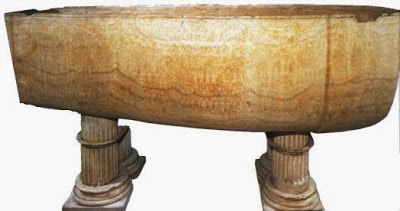
2. Calcite sarcophagus of "Seti the Great"-The sarcophagus of the Egyptian Pharaoh Seti I collected by Giovanni Belzoni. The sarcophagus rested in the British Museum for a time before it was rejected in 1824 by trustees of the British Museum and was snapped up by Sir John Soane as the star attraction in his Soane Museum, London.
This has almost always been seen as a mistake by the trustees but it must be remembered that the museum had just spent a wad of cash on acquiring the Parthenon marbles. An amazing moment when not one but two amazing finds comes on to the market at the same time, and I myself would take the marbles also.
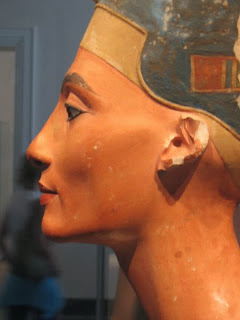
3. Limestone bust of Nefertiti - Discovered by archaeologists at Tel el Amarna in December of 1912, its acquisition for Berlin through division of finds is perhaps the most controversial decision made by representatives of Egypt's antiquity authorities. The bust is currently in Berlin's Neues Museum. The bust may well be the piece that the Egyptian antiquities authority most misses not having, that or the Rosseta stone?
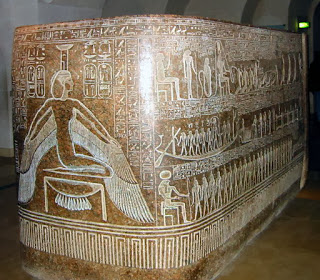
4. The Sarcophagus of Ramses III (Louvre D1=N337), its lid in the Fitzwilliam (E.1.1823) - The box was collected by showman Giovanni Belzoni in 1816 for the collection of British Consul-General Henry Salt and was acquired for the collection of the Louvre in the early 1820's. since Mr. Belzoni was only asked to collect the sarcophagus box for Consul-General Salt, Mr. Belzoni claimed the sarcophagus' lid for himself thus the lid ended up in the Fitzwilliam Museum separate from its box, unfortunately.
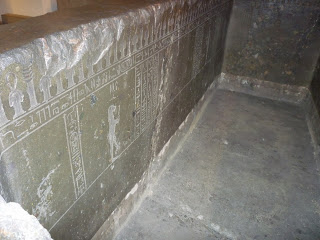
5. Sarcophagus of Nectanebo II (EA 10) - Discovered being used as a ritual bath in the courtyard of a mosque by Napoleon's men, it was transferred to the British in the treaty of Alexandria in 1801. The sarcophagus is at present in the British museum.
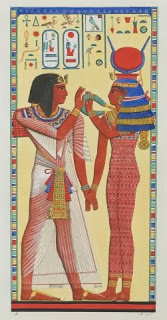
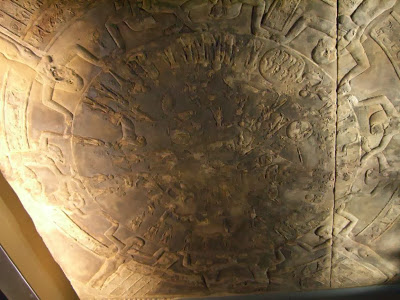
7. The Denderah Zodiac - In another disgraceful colonial act the zodiac was taken from the little temple on the roof of the temple of Hathor at Denderah. The temple was badly damaged by the zodiacs removal in 1820, the ceiling is now in the Louvre.
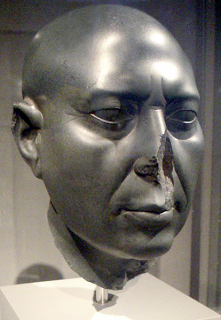
8. The Berlin green head - Truly a masterpiece of portrait sculpture in the round unfortunately the Berlin head has no notable provenance the piece being given to the museum by benefactor James Simon who also owned the bust of Nefertiti represented in this article. The head has the quality of the royal work shops and may well represent a high official of the late to Ptolemaic periods.
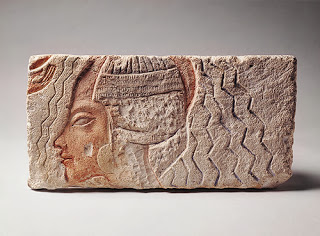
9. The Norbert Schimmel Talatats- These Amarna period architectural blocks from the middle of the 14th century B.C. are a fortunate survival as the result of the Pharaoh Akhenaten becoming an immediate enemy to the state and his unusual monuments were dismantled being used as fill in his successors monuments, thus the fine preservation. This particular block displays another feature of the Amarna royal monuments in that the kings wives iconography's are often usurped by their successors as this talatat may be re-carved from a former kings wife to a daughter of the king, the result of two women of the kings court being represented.
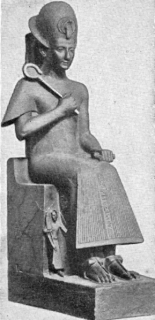
10. Statue of Ramses II in the Turin Museum- For a king that ruled more than six decades creating countless statues of himself this is certainly the finest, entering the Turin Museum in a number of pieces, its quality obvious. The statue was acquired in the early 19th century by Consul-General Drovetti and bought with a large collection including a number of very fine statues.
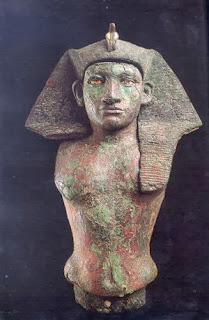
11. Bronze bust of Middle Kingdom Pharaoh Amenemhet III - A collection of Middle Kingdom bronzes came to light some years ago with the best pieces including the bust of the king ending up in the George Ortiz collection in Switzerland as provenance unknown. The collection also includes statuettes of a queen and named viziers each in themselves important.
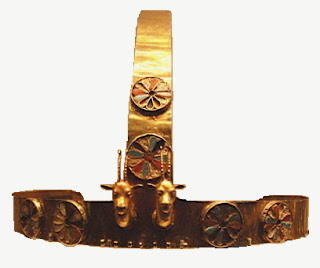 12. Gold Crown of a Wife of Thutmosis III- Locals found the tomb of three wives of Thutmosis III in 1916 breaking the assemblage of jewels into a number of different lots which were acquired and reassembled by the conservators at the Metropolitan Museum of Art.
12. Gold Crown of a Wife of Thutmosis III- Locals found the tomb of three wives of Thutmosis III in 1916 breaking the assemblage of jewels into a number of different lots which were acquired and reassembled by the conservators at the Metropolitan Museum of Art.
A very prestigious list of ancient Egyptian art of the first rank, objects that are only a few among many gracing some of the best collections in the world. These pieces are in themselves some of Egypt's most important ambassadors protected well in some of the finest museums and collections that can preserve ancient Egypt from all corners of the world.
Photo's;
Header: Vulture Ceiling, Global Egyptian Museum
1. Rosseta Stone by Hans Hillewaert
2. Sarcophagus of Seti I by Martin Churchill
3. Bust of Nefertiti by Federico Cinquepalmi
5. Nectanebo II sarcophagus by Michael Harding
8. Berlin Green head by Keith Schengili-Roberts
9. "Relief of Queen Kiya [Egyptian]" (1985.328.8) In Heilbrunn Timeline of Art History. New York: The Metropolitan Museum of Art, 2000–. http://www.metmuseum.org/toah/works-of-art/1985.328.8. (October 2006)
11. George Ortiz collection, Photo: Al Ahram
12. Gold Crown AnnekeBart
- Foreign Teams On Missions In Egypt
Egyptian Gazette As ever with the Egyptian Gazette this story will only be available for a few days. More than one hundred foreign archaeological teams are currently working in Egypt and all are hoping to discover new monuments and artefacts that might...
- Tuesday's Egyptian
...
- Interior Of The Sarcophagus Of Nectanebo Ii
This is the left side interior looking towards the foot of the sarcophagus of Nectanebo II which was later drilled to be a ritual bath at the Attarin Mosque in Alexandria. The sarcophagus came to the British Museum as a gift of King George III who...
- Truth On Display
Certainly the battle of Egypt's authorities to retrieve artifacts that have gone abroad over the last 200 years is in full swing though the bust of Nefertiti is the star of this cause there are still many more questionable important artifacts. I have...
- Not A Loan
This article is on the Rosetta stone and Egypt's Secretary general of the Supreme counsel of antiquities desire to have it back not as a loan but permanent. In recent weeks Dr. Zahi Hawass has become less diplomatic with not only the British museum...
Egypt
The Ambassadors of Ancient Egyptian Art

1. Rosetta stone (EA 24)- Discovered in the foundations of a fort at Rosseta by Napoleon's men in 1798 the stone was handed over to the British in the treaty of Alexandria in 1801. The stone was given to King George III who in turn donated it to the British Museum.
It is in fact the Rosseta stones modern history that gives its importance in the learning to read the Egyptian hieroglyphs, otherwise the stone would be of limited importance to ancient Egyptian history.
2. Calcite sarcophagus of "Seti the Great"-The sarcophagus of the Egyptian Pharaoh Seti I collected by Giovanni Belzoni. The sarcophagus rested in the British Museum for a time before it was rejected in 1824 by trustees of the British Museum and was snapped up by Sir John Soane as the star attraction in his Soane Museum, London.
This has almost always been seen as a mistake by the trustees but it must be remembered that the museum had just spent a wad of cash on acquiring the Parthenon marbles. An amazing moment when not one but two amazing finds comes on to the market at the same time, and I myself would take the marbles also.

3. Limestone bust of Nefertiti - Discovered by archaeologists at Tel el Amarna in December of 1912, its acquisition for Berlin through division of finds is perhaps the most controversial decision made by representatives of Egypt's antiquity authorities. The bust is currently in Berlin's Neues Museum. The bust may well be the piece that the Egyptian antiquities authority most misses not having, that or the Rosseta stone?

4. The Sarcophagus of Ramses III (Louvre D1=N337), its lid in the Fitzwilliam (E.1.1823) - The box was collected by showman Giovanni Belzoni in 1816 for the collection of British Consul-General Henry Salt and was acquired for the collection of the Louvre in the early 1820's. since Mr. Belzoni was only asked to collect the sarcophagus box for Consul-General Salt, Mr. Belzoni claimed the sarcophagus' lid for himself thus the lid ended up in the Fitzwilliam Museum separate from its box, unfortunately.

5. Sarcophagus of Nectanebo II (EA 10) - Discovered being used as a ritual bath in the courtyard of a mosque by Napoleon's men, it was transferred to the British in the treaty of Alexandria in 1801. The sarcophagus is at present in the British museum.

6. Doorjambs from the hall of beauties in the tomb of Seti I - In an act of vile arrogance two scenes were sawed from the walls of Seti's tomb (Kv17) in the Valley of Kings by the Champollion and Rosselini expedition of the late 1820's. The doorjambs were collected for the Louvre and Turin Museums.

7. The Denderah Zodiac - In another disgraceful colonial act the zodiac was taken from the little temple on the roof of the temple of Hathor at Denderah. The temple was badly damaged by the zodiacs removal in 1820, the ceiling is now in the Louvre.

8. The Berlin green head - Truly a masterpiece of portrait sculpture in the round unfortunately the Berlin head has no notable provenance the piece being given to the museum by benefactor James Simon who also owned the bust of Nefertiti represented in this article. The head has the quality of the royal work shops and may well represent a high official of the late to Ptolemaic periods.

9. The Norbert Schimmel Talatats- These Amarna period architectural blocks from the middle of the 14th century B.C. are a fortunate survival as the result of the Pharaoh Akhenaten becoming an immediate enemy to the state and his unusual monuments were dismantled being used as fill in his successors monuments, thus the fine preservation. This particular block displays another feature of the Amarna royal monuments in that the kings wives iconography's are often usurped by their successors as this talatat may be re-carved from a former kings wife to a daughter of the king, the result of two women of the kings court being represented.

10. Statue of Ramses II in the Turin Museum- For a king that ruled more than six decades creating countless statues of himself this is certainly the finest, entering the Turin Museum in a number of pieces, its quality obvious. The statue was acquired in the early 19th century by Consul-General Drovetti and bought with a large collection including a number of very fine statues.

11. Bronze bust of Middle Kingdom Pharaoh Amenemhet III - A collection of Middle Kingdom bronzes came to light some years ago with the best pieces including the bust of the king ending up in the George Ortiz collection in Switzerland as provenance unknown. The collection also includes statuettes of a queen and named viziers each in themselves important.

A very prestigious list of ancient Egyptian art of the first rank, objects that are only a few among many gracing some of the best collections in the world. These pieces are in themselves some of Egypt's most important ambassadors protected well in some of the finest museums and collections that can preserve ancient Egypt from all corners of the world.
Photo's;
Header: Vulture Ceiling, Global Egyptian Museum
1. Rosseta Stone by Hans Hillewaert
2. Sarcophagus of Seti I by Martin Churchill
3. Bust of Nefertiti by Federico Cinquepalmi
5. Nectanebo II sarcophagus by Michael Harding
8. Berlin Green head by Keith Schengili-Roberts
9. "Relief of Queen Kiya [Egyptian]" (1985.328.8) In Heilbrunn Timeline of Art History. New York: The Metropolitan Museum of Art, 2000–. http://www.metmuseum.org/toah/works-of-art/1985.328.8. (October 2006)
11. George Ortiz collection, Photo: Al Ahram
12. Gold Crown AnnekeBart
- Foreign Teams On Missions In Egypt
Egyptian Gazette As ever with the Egyptian Gazette this story will only be available for a few days. More than one hundred foreign archaeological teams are currently working in Egypt and all are hoping to discover new monuments and artefacts that might...
- Tuesday's Egyptian
...
- Interior Of The Sarcophagus Of Nectanebo Ii
This is the left side interior looking towards the foot of the sarcophagus of Nectanebo II which was later drilled to be a ritual bath at the Attarin Mosque in Alexandria. The sarcophagus came to the British Museum as a gift of King George III who...
- Truth On Display
Certainly the battle of Egypt's authorities to retrieve artifacts that have gone abroad over the last 200 years is in full swing though the bust of Nefertiti is the star of this cause there are still many more questionable important artifacts. I have...
- Not A Loan
This article is on the Rosetta stone and Egypt's Secretary general of the Supreme counsel of antiquities desire to have it back not as a loan but permanent. In recent weeks Dr. Zahi Hawass has become less diplomatic with not only the British museum...
